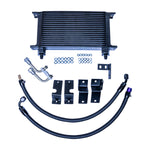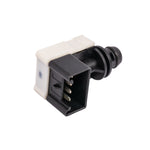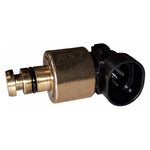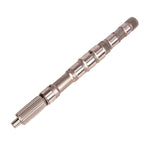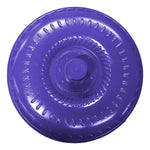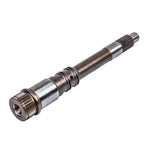You have no items in your shopping cart.
68RFE vs. Aisin vs. Allison: if you own a 6.7L Cummins, you’ve probably lived some of this debate firsthand. RAM trucks deliver monumental torque, but the transmissions bolted behind them haven’t always kept pace. After years of field data, customer builds, dyno sessions, and heavy towing, one answer rises above the noise: an Allison LCT-1000 swap—integrated with ATS Diesel’s TRANSLator electronics and conversion hardware—delivers the most reliable, adaptable, and confidence-inspiring driving experience for Cummins owners.
This article breaks down where the factory 68RFE and Aisin AS69RC come up short, why the Allison’s architecture solves those pain points, and how ATS Diesel’s conversion system ties it all together so your RAM behaves like it came that way from the factory—only stronger.
Why This Comparison Matters
Diesel truck ownership usually involves a mix of jobs: daily commuting, towing equipment or toys, sustained highway grades, winter temps, hot summers, and occasional performance tuning. A great transmission should:
- Hold line pressure and clutch capacity under elevated torque.
- Shift predictably and smoothly when the trailer is on the hitch.
- Adapt to changing conditions without cooking the fluid.
- Integrate cleanly with factory electronics—no warning lights, no weird limp modes.
Measured against that standard, the 68RFE and Aisin each come with compromises that cost you time, money, and confidence. The Allison platform, by contrast, starts with the right core architecture—and with ATS integration, it simply works.
The 68RFE: Fragile Foundation, Costly to “Fix”
Launched in 2007.5, the 68RFE was intended to compete with Ford’s TorqShift and GM’s Allison. Its lineage traces back to smaller RFE units used in gas applications, and the carry-over design shows. Typical weak points include:
- Converter and valve body weaknesses—heat, cross-leaks, and pressure loss under sustained load.
- Undersized clutch packs—limited torque capacity, especially with bigger tires, tunes, or heavy trailers.
- Thermal management—marginal from the factory; towing in hot climates rapidly accelerates failure.
Yes, the aftermarket has an answer for nearly every weak link: billet valve body components, upgraded converters, pump fixes, deep pans, and reinforced shafts. But to make a 68RFE truly robust, you end up replacing almost everything. The real-world tally to build a “bulletproof” 68RFE commonly lands in the $8,000–$10,000 range, and even then you’re still working within small-frame limits.
If your plan is to keep a factory-style transmission, ATS offers one of the most advanced solutions available: ATS 68RFE Transmission Package for 6.7L Cummins. For parts and service components, browse all 68RFE components. But if your end goal is ultimate reliability and best-in-class drivability, keep reading.
The Aisin AS69RC: “Heavy-Duty” on Paper, Handcuffed in Practice
RAM’s Aisin option arrived with commercial-grade marketing and, to its credit, some beefier internals compared to the 68RFE. In practice, owners and shops still report chronic issues:
- K2 clutch hub/pack vulnerability—known to fail under repeated heavy towing.
- Power derating during shifts—to protect itself, the TCM pulls power; the result can be sluggish, even unsafe, hesitation when merging.
- Clunky shift quality—inconsistent feel under mixed loads and grades.
- Locked-down electronics—very limited aftermarket tuning; little room to improve behavior.
Repair costs are steep, and drivability remains a pain point. For many owners, the effort required to make an Aisin “good enough” can rival or exceed the cost of an Allison swap—without delivering the same outcome.
The Allison LCT-1000: Right Architecture, Right Results
The Allison LCT-1000 earned its reputation in Duramax and medium-duty applications. It starts with what matters:
- Large clutch packs and gearsets—high torque capacity from the factory.
- Robust shafts and hard parts—reduced twist and deflection under load.
- Adaptive shift strategy—refines timing and pressure for smooth, intelligent behavior.
- Excellent thermal behavior—especially when paired with deep pans and proper cooling.
On the road, the Allison delivers smooth, predictable shifts; strong converter lockup for grade control; and confident towing manners that make long hauls feel uneventful—in the best way possible.
How ATS Makes the Allison “Factory-Clean” in Your RAM
Hardware alone doesn’t make a great swap—electronics and integration do. That’s where ATS Diesel’s conversion system changes the game. Our patent-pending bellhousing and ATS TRANSLator electronics create a seamless bridge between the Cummins ECU and the Allison TCM so OEM-level functions are preserved:
- Push-button start and cruise control
- Tow/Haul, Tap-Shift, and Electronic Range Select
- Transfer case integration and 4WD logic
- Proper CAN messaging—no warning lights or “hacky” workarounds
The result feels OEM—only better. You get Allison smoothness and capacity with RAM controls that behave like you expect. Explore the full lineup here: ATS Allison Conversion Kits & Components.
Gear Ratio Comparison
| Gear | Allison 1000 | 68RFE | Aisin AS69RC |
|---|---|---|---|
| 1st | 3.10:1 | 3.23:1 | 3.75:1 |
| 2nd | 1.81:1 | 1.83:1 | 2.00:1 |
| 3rd | 1.41:1 | 1.41:1 | 1.34:1 |
| 4th | 1.00:1 | 1.00:1 | 1.00:1 |
| 5th | 0.71:1 | 0.81:1 | 0.77:1 |
| 6th | 0.61:1 | 0.62:1 | 0.63:1 |
| Reverse | 4.49:1 | 4.44:1 | 3.54:1 |
What it means on the road: Allison’s spread provides strong launch torque, tidy RPM drops that keep the Cummins in its sweet spot, and a double overdrive for relaxed highway cruising and excellent EGT control under load.
Cost, Value, and Total Ownership
Customers often compare “built 68RFE” pricing to an Allison swap. On paper, a stout 68RFE can look slightly cheaper up front. In practice, most serious builds end up within striking distance of a conversion, and some exceed it after repeat repairs. By contrast, a properly spec’d Allison package offers long service intervals, predictable behavior, and high resale value—and it’s built on a platform that wants to handle torque.
ATS offers staged systems to fit your goals—see Full Allison Conversion Kits for 6.7L Cummins—and we also stock Allison components and service parts for GM applications here: Allison Components.
Which Owners Benefit Most from an Allison Swap?
- Heavy towers: 12K–30K combined weight, long grades, headwinds, and heat. You’ll feel the difference in converter control, gear spacing, and temperature stability.
- Tuned daily drivers: Mild to moderate power increases that routinely punish small clutches and fragile valve bodies.
- Work trucks: Stop-and-go, job-site crawling, and mixed payloads demand predictable shifts and durability.
- Long-term owners: If you plan to keep the truck, the Allison’s service intervals and resale value make the math easy.
Common Questions
Will I lose factory features?
No. With ATS integration, you retain push-button start, cruise, tow/haul, Tap-Shift, electronic range select, and proper 4WD/transfer-case behavior. That’s the power of the TRANSLator system and our harnessing strategy.
Is tuning required?
The Allison’s adaptive logic handles most driving scenarios gracefully. If your engine calibration is already optimized for towing or performance, the Allison simply gives that power a safer, more stable path to the ground.
What power levels can I support?
ATS stages span from stout towing packages to four-figure horsepower capability. Our higher stages add billet input and intermediate shafts, upgraded converters, and clutch strategies to match your goals.
What about serviceability?
Allison parts and fluids are widely available, with a huge knowledge base across the industry. Pair that with ATS hardware and documentation, and long-term ownership is straightforward.
When the 68RFE Still Makes Sense
Not every use case demands a swap. If you tow light, run stock power, and prioritize lowest initial cost, a well-built 68RFE can serve. Start with the ATS 68RFE package and maintain it carefully using quality fluid, thermal management, and periodic inspection. For individual parts, see 68RFE components. But if your plans include real towing or meaningful power, the Allison is the headache-free path.
Installation Overview (What to Expect)
- Assessment & staging: Choose the correct ATS kit (Stage 1–4) for power and usage.
- Hardware fitment: Bellhousing solution, converter, pan, shafts (per stage), crossmember/driveline considerations.
- Electronics & harness: TRANSLator integration, CAN communication, validation of factory functions.
- Fluids & fill: Correct Allison-spec fluid, level setting, and initial heat cycle.
- Road test & learn: Adaptive strategy “learns” your truck; verify tow/haul, Tap-Shift, ERS, and 4WD behavior.
The Bottom Line
- 68RFE: Economical to service but fundamentally small; expensive to build right and still capacity-limited.
- Aisin AS69RC: Beefier on paper but clunky, locked down, and costly to repair.
- Allison LCT-1000 + ATS Conversion: Best-in-class drivability, capacity, and integration for the Cummins platform.
If you want reliability first, towing composure, and room to grow, the Allison swap is the smart investment. Start here: Allison Conversion Kits & Components or jump straight to the full 6.7L systems: Full Conversion Kits for 6.7L Cummins. If you’re comparing GM Allison parts or doing mixed-fleet work, browse Allison components as well.
Ready to Build It Right?
Your Cummins deserves a transmission that matches its reputation. With ATS Diesel’s engineered hardware and integration, the Allison behaves like it was born in your RAM—only tougher, smoother, and more trustworthy under real load. Get the details, confirm fitment, and choose your stage now:








